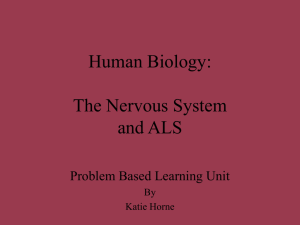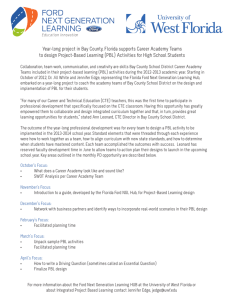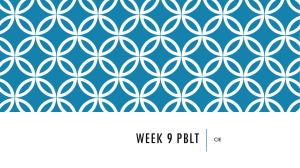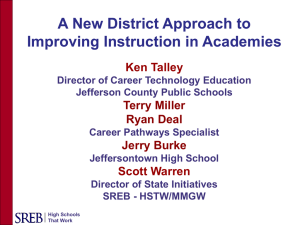Setting the Standard for Project Based Learning
advertisement
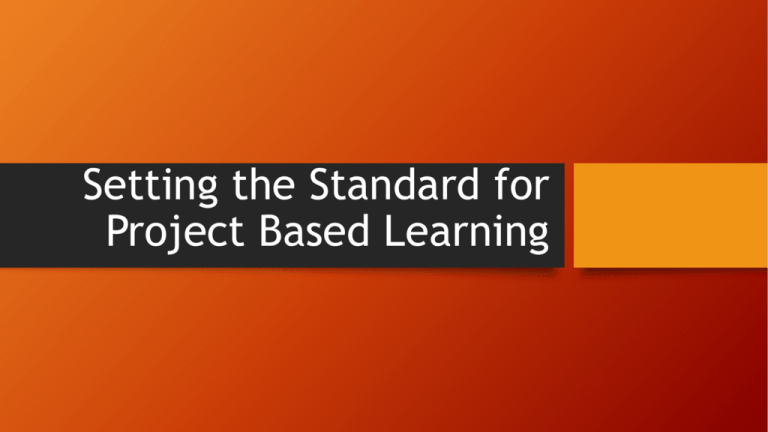
Setting the Standard for Project Based Learning What the Heck Is Project-Based Learning? • PBL: The Elevator Speech • An elevator speech is a brief, one- or two-sentence response you could give someone in the amount of time it takes to go from the first floor to the second floor in an apartment building. I like this visual, and I use it with my students because getting to the point and encapsulating the gist of something is vital in today's speaking- and writing-heavy world. • So the elevator opens up, a guy walks in and out of the blue asks you, "What the heck is project-based learning anyway?" I don't know why he would ask that, but for the purposes of this fantasy, it seems that any Joe-off-the-street is fascinated by your response. • You respond accordingly: "PBL is the act of learning through identifying a real-world problem and developing its solution. Kids show what they learn as they journey through the unit, not just at the end." • "That's it?" the guy asks. • "Well, no," you reply. "There's more to it than that, but this is your floor, and we're out of time." He gives you a brief nod of thanks and departs, leaving you to think of all the richness that this definition does not, in fact, impart. • After all, if we just look at that definition, it doesn't state certain trends in PBL. Heather Wolpert-Gawron Originally Published: January 26, 2015 | Updated: August 13, 2015 What the Heck Is Project-Based Learning? • A More Elaborate Response • So now that it's just you (the reader) and me again, let's bump up that definition so that it more accurately captures the power of this learning strategy: • PBL is the ongoing act of learning about different subjects simultaneously. This is achieved by guiding students to identify, through research, a real-world problem (local to global) developing its solution using evidence to support the claim, and presenting the solution through a multimedia approach based in a set of 21st-century tools. • Kids show what they learn as they journey through the unit, interact with its lessons, collaborate with each other, and assess themselves and each other. They don't just take a test or produce a product at the end to show their learning. • You realize that this definition, while closer to accurate than the previous version, would have caused his eyes to glaze over (as yours may have just now), and you decide that the earlier definition is by far the more efficient version, even as it shortchanges the awesomeness of the strategy. • Because PBL is awesome when it is implemented by teachers who buy into its methods. It is exciting to teach using PBL, and your excitement, in turn, causes excitement in your clients, the students. Heather Wolpert-Gawron Originally Published: January 26, 2015 | Updated: August 13, 2015 Elements of PBL Lessons • Role-playing • Real-world scenarios • Blended writing genres • Multiple reading genres • Authentic assessments • Authentic audiences • Real-world expertise brought into the classroom • Units that assess multiple skills • Units that require research and comprehension of multiple subjects • Student choice • Collaboration • Multiple methods of communication (writing, oral speaking, visual presentations, publishing, etc.) Project Based Learning Pacing Guide Project Based Learning in the Middle School FACS Classroom General Notes • Designing a project is like planning a unit, instead of a lesson • Multiple lessons, activities, tasks, and student assignments • Moves through phases rather than steps, toward a culminating activity • Modifications can be made during some lessons • Projects take more time and thought • Not a straightforward process • Start with general ideas, reflect, seek feedback What Project Based Learning Is Not • Dessert Projects: At or near the end of a unit as a reward; making something tangible, such as a model, video, poster, etc. • Side dish Projects: Occurs during a traditionally taught unit or outside the bounds of the unit; homework assignment; design or conduct a science experiment; create a family tree; observe and record data. • Buffet Projects: Variety of activities during a unit, most are hands-on, students sometimes get to choose which ones they do or what topics to pursue; Often very impressive in their complexity, but still considered “dessert” or “side dish” projects. • End-of-unit performance assessments or applied learning tasks: Demonstrations of what the student has learned; problem solving; answering questions through written projects or presentations • Why are these not project-based? They are not the main course. They are not thought of as the method of instruction, but rather an after thought. Projects Versus Project Based Learning Project Project Based Learning Supplemental to a unit The project is the unit, or a major vehicle for teaching content standards within a unit Task is based on following directions from teacher and is repeated year after year Task is open-ended and involves student voice and choice; often differs from year to year Typically done individually Done in collaboration with a team Done independently, often at home Done with teacher guidance, much of it during school hours Focused on the project; the product may even be called “the project” The project includes a substantial inquiry process and the creation of a product Not authentic to the real world or to students’ lives Authentic to the real world or to students’ lives, or both Types of Projects • • • • • Solving Real World Problem Meeting a Design Challenge Exploring an Abstract Question Conducting an Investigation Taking a Position on an Issue Project Design Step 1: Considering your Context • Which students will be involved? • When will I conduct the project? • How simple or complex will my project be? Defining Features of Simpler Vs More Complex Projects Simple Project More Complex No. of subj. areas One subject Multiple subjects Who is involved? One teacher Several teachers Where? Classroom, school On and off campus What products are created? One product (not much time) Multiple or elaborate Technology to be used? Fewer and familiar tech tools Several tech tools to learn • How long will my project be? • How many subject areas will be included? Project Design Step 2: Generating an Idea for a Project • Customizing someone else’s project Does it address the standards/content I need to target? Is it main-course PBL, or only a “dessert” project? Does it reflect Gold Standard PBL design criteria? Will my students find it engaging? Is the length and level of complexity appropriate for my students and for me? • How much would I need to do to adapt this project so it will work for my students and me? • • • • • Project Design Step 2: Generating an Idea for a Project (continued) • Generating Your Own Idea • • • • • Issues in your school or community Current events Real-world problems Content standards Your students’ lives and interests Project Design Step 3: Building the Framework • Setting learning goals • 1) key knowledge and understanding • Identify which content standards are most important and which standards are most appropriate. • 2) key success skills • Remember Gold Standard Project Learning prioritizes three skills: critical thinking/problem solving, collaboration, and self-management. • Selecting major products • Does the product provide enough evidence that students have met the targeted goals for learning or will I need a combination of products? • Is the product as authentic as possible? • Is the product feasible? • What products will be created by individual students or done as a team? • Will student teams all create the same product or different products? Project Design Step 3: Building the Framework (continued) • Deciding how products will be made public • • • • • Put it use in the real world Give presentations to an audience, live or online Conduct an event Display in a public space Publish it, post it, or send it to someone • Writing a driving question • A statement in student-friendly language of the challenging problem or question at the heart of the project. • Driving questions can also be called “essential questions” or “problem statements” • Driving questions should meet three criteria: • Engaging for students • Open-ended • Aligned with learning goals Pause and Reflect • Consider your project from the perspective of Gold Standard Project Based Learning • Consider your project design from the perspective of your students • Consider your project design from the perspective of a colleague or administer. • The best way to reflect on your project’s design is to show it to other people and invite their feedback.



